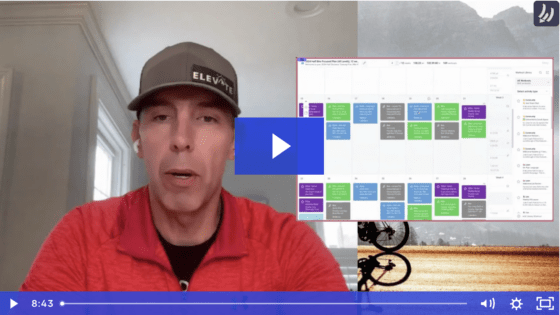
Everyone knows that rest is required after a big race. But what if you have another race on the calendar? How much rest is appropriate, giving yourself space to heal, but also allowing for performance in the next event?
This is a difficult question to answer because there are many variables. But regardless of how your first race went down, with your attention directed at a vet number to it’s time to make sure that every action you take improves your potential for performance in that second event.
Here is how we help athletes navigate the space between two Ironman distance triathlons within the course of a six-week period.
Week One: Recovery
The first order of business is to recover as quickly as possible. The structure of that recovery is largely dictated by your performance on race day. If you ran significant portions of the run and were highly competitive throughout the day, you have likely done more damage to your body than the average participant. That said, if you were out on the course for longer than 14 hours, your body itself has experienced quite a few micro-level traumatic experiences. Whether it’s digestive or muscular or structural. If you fall in either one of those outlying windows, you really need to be paying attention here.
The first two or three days after the race are all about rest. You should be refueling your body from a fluid and carbohydrate perspective, minimizing time on your feet, and focusing on full recovery. This means proper sleep, reduced movements and ideally limited travel. There’s nothing worse than finishing a big event and then having a long trip the very next day, if you have the opportunity to avoid that you should.
During this initial timeframe, you will go through several phases of exiting that offense. This often is accompanied by serious discomfort. This is typical for everyone, but if you notice lingering issues that are not resolving after the third day it’s worth taking an extra look. Sore quadriceps are one thing, still not being able to walk properly after 3 days? That could be a problem.
How active should I be in this window? After two to three days of full rest, you can begin doing some light activity. Target should be two to three sessions of non-weight-bearing workouts (swim or bike). You can also incorporate some walking or short hiking.
What are the bonus points in this week? A very light massage can be quite helpful if you’re able to secure one. Not just on your lower extremities, which will likely not really like the body works. But also the upper body which has taken on a lot of the stress and strain of the race as well.
Week Two: Transition
Top priority here is a return to your norma, pre-event training volume. This can be measured in time or Training Stress Score.
You’ll need to be careful not to push this to hard; after all your body is still recovering. The rules remain the same as the first week:
- Don’t sacrifice your overall sleep
- Training should be predominantly non-weight bearing activity
- You should stick to a single training session per day when possible
- The weekend workouts should be “normal” for you now that you are 10+ days into recovery.
What’s New This Week? You can begin to layer in some short run workouts. Target two to three run sessions, none longer than 45 minutes. The pace should be very easy (Zone 1) on flat terrain. At least one can be a brick run, off the bike, on the weekend.
Keep the Carbs Up! You’ll need to eat significantly more workout calories for the longer sessions. You might need to eat in every session! Pre-event you might get away with no calories for an hour run…post-event you’ll likely need a gel or some bloks to keep things rolling.
Wind Things Down. It’s important that even as you re-enter, at a basic aerobic level, that you continue to take care of your body. The fastest way to get back to recovery mode is to exit each workout intentionally. Add a short cool down walk or spin at the end of each session. Refuel and hydrate quickly, then light stretching. While stretching, focus on deep breaths and slow exhalations.
Week Three and Four: Come On Ride the Train
Two weeks post race, and your training should be almost 100% normal at this point. At least it feels like the right thing to do physically and mentally. But don’t just train to train, train to improve.
Recognize that significant physical improvements and a short window are physiologically impossible. Everybody only has so much capacity for work, and trying to create new fitness and it’s short window is not a good idea. But that doesn’t mean that all improvement is off the table.
Take a look at your race report to identify areas where you can imrpove. Fitness isn’t the only means through which you can achieve speed gains. But you’ll need to incorporate these into your routine. Here are a few example.
- Improved Transitions – eliminate deadtime by simplifying this process, pushing as much “on to the bike” or “on to the run” vs doing it while standing still .
- Better Bike Position – Are there changes to your bike fit that will help? You might need to move some bolts or perhaps just better execute the aero position.
- Higher Cadence – Running on race day is often “sloppy” as compared to regular training. You can use cadence – your watch likely has a metronome – to stick to a target that will help you keep your speed up.
Test Your Race Readiness This mini block should end with another race rehearsal workout. It’s an opportunity to reconcile your “new clothes quote nutritionist and how your body feels under the strain of a race duration workout. Any changes from the normal Baseline should be noted and incorporated into your race plan.
Watch the Effort! Remember that your body is still recovering from the big event. It’s quite possible that your normal training efforts can seem much harder then before. A nice easy 8 minute per mile pace on the run could give you a zone 3 or zone for heart rate! This is a sign that your body is still processing work and it’s not ready for higher levels of intensity. Monitor your critical vital signs closely to adjust your workout pacing accordingly — to get the Heart Rate you expect. You only have so many heartbeats you can use to be successful on race day. We don’t want to push in training until you are ready for it.
Week 5: Starting to (Re)Taper
Traditional training has a declining taper in a straight line from the second week into race day. This is a gradual “shedding” of training load. It’s an important process simply because most athletes are carrying significant fatigue at this point. But the double race scenario makes this approach less effective.
You are not in a position where you need to shed a lot of fatigue. Instead, we need to ensure that you are showing up for the race rested and ready to go. This also means that you are sharp.
Here’s how we do it:
- Monday and Tuesday are rest days. Monday is off, and Tuesday is a light swim only.
- Wednesday is a solid bike-run session with intensity above race day effort on both. A 90-minute bike and 30-run here works well.
- Thursday is your last long run, somewhere in the 1:20 t0 1:40 time range, at race pace.
- Friday is a long swim.
- Saturday is a bike-run session, very aerobic, where the bike duration is approximately 50% of the expected time on race day.
- Sunday is an easy aerobic run, approximately an hour, followed by stretching and or yoga.
Week 6: Race Week
Similar to last week, we can’t do too much here as we need to be mindful of the effort to come on race day. But there are spaces where you can see some advantages.
First, you are a traveling pro at this point! Get it all together early and be as de-stressed as possible. You have experience and can do it 10x better than last time.
Second, plan on split workouts on site. So an early AM bike recon ride, for example, with a 20-30 minute easy run in the evening just before dinner.
Third, try to resist the pull of the expo or additional time on your feet. Use the extra time to review your race plan and identify the areas of the course that could work for / against you.
Fourth, take your time at equipment drop off to review the transition area and plan how you are going to execute the day. Again, this is all free speed.
Fifth, modify your pre-race fueling plan just slightly. Start the hydration plan three days out. Nothing excessive but at least 1 bottle of your sports drink a day. And you have to really nail the day beore carbohydrates, starting with an early breakfast (pancakes or french toast anyone) and taper that off through a moderate lunch and a light early dinner. You need all the stored glycogen you can get!
Off to the Races
Soon you’ll be in the water and racing away…your happy place! Be patient with your body and focus on great form and fluidity. It could take a while for your legs and lungs to come around, and that’s 100% okay.
Rest assured your fitness is there, and it’s ready to do the work. Best of luck!




Leave a Reply